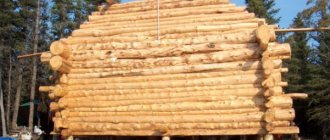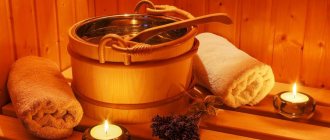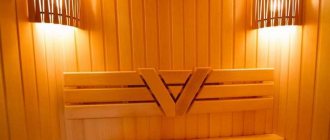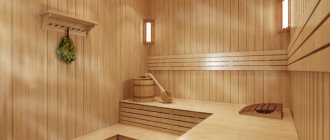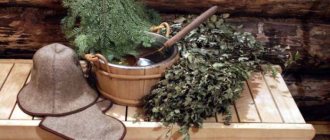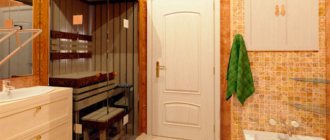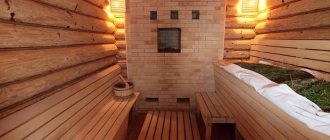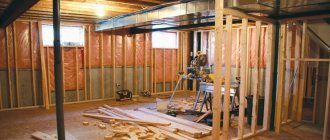In order for a Russian bath, Turkish hammam or Finnish sauna to bring maximum benefit and pleasure, it is important to know what temperature and humidity level should be maintained in them, who should not visit certain steam rooms, as well as some of the subtleties of staying in these wonderful public institutions.
Characteristic differences
In a Russian bath
high air humidity. The heat level in it is considered to be quite low. The humidity level can be changed by pouring water onto the hot stones in the oven. The air in the bathhouse warms up to 70 ° C. Birch brooms are actively used in the steam room. They perform the function of a kind of massager.
Visiting a bathhouse is beneficial for health:
Muscle relaxation occurs. Impaired blood circulation is restored. The pores on the face expand. The elimination of toxins is activated.
The temperature
in a Turkish bath
does not exceed 50 ° C, humidity reaches 100%. She is popular with women. The steam in such a bath is characterized by increased density. You can stay in it for much less time than in a Russian bathhouse.
In the Finnish sauna
dry air and high temperature. When you are in it, you often experience excessive dryness in the mouth and a burning sensation in the nose. The average temperature in such a sauna is 80-110 degrees. The humidity in it is quite low (11-15%).
The benefits of a Finnish sauna
The hot and dry air for which the Finnish sauna is famous is very beneficial for the human respiratory system. It is important to avoid overheating or hypothermia, as this can be harmful to health.
Useful properties include the following:
- Improving metabolism and burning excess weight.
- Cleansing the body of waste and toxins.
- Treatment of respiratory diseases, bones and joints, as well as various injuries.
Exposure to heat
When taking bath procedures, an increase in blood pressure is observed. As a result, congestion in the limb area is eliminated. People who have been diagnosed with the following ailments should refrain from health procedures:
epileptic seizures; hypertension; ischemia; brain pathologies; oncological diseases; bronchitis occurring in acute form; abnormalities in the functioning of the thyroid gland.
Avid steamers should be wary if they notice symptoms of overheating. These include:
severe dizziness; the occurrence of nausea; poor coordination of movements.
If you follow certain rules when visiting the steam room, you can get rid of problems with blood circulation, colds, and allergic reactions. It is also effective for overweight people. Wellness treatments provide a rejuvenating effect. They prevent premature skin aging and normalize metabolism. Under the influence of hot air, resistance to viral infections increases, tension is eliminated, and heart rate is normalized.
First visits to the bathhouse
A trip to the bathhouse requires careful preparation of brooms and other things necessary for effective steaming. There are several main types of brooms:
- Birch trees have a beneficial effect on the human bronchi, heal the skin, and help restore muscles and joints.
- Oak - have a calming effect, perfectly restore the skin, reducing its oiliness.
- Eucalyptus - are a good prevention of respiratory diseases.
For convenient use of a broom, it is recommended to acquire special mittens. When the optimal temperature for the bath is reached, everyone sits on shelves on which sheets need to be laid. You also need a second sheet to wrap yourself in. It is mandatory to have a hat that will protect your head from overheating and keep your hair in normal condition. Treatment headgear is made from felt and comes in a huge variety of shapes available. Terry towels are used for drying, and it is best to walk here in slippers that are not afraid of water.
Before your visit, you can steam your feet, which will allow the blood to drain from your head and relieve your heart. All preparations for the visit should take place at a calm pace, since the bustle that arises during preparations can negatively affect the mood in the steam room. You should not expect that the steam room will become the place for a grand feast, since drinking alcohol and overeating during the steam room is prohibited.
A few rules for beginners who don’t know at what temperature they can steam in a sauna:
- Before entering the steam room, it is recommended to warm up or swim in the pool for 10-15 minutes.
- It is worth remembering that you need to breathe through your nose here, since the sinuses in the nasopharynx reduce the heat of the air before it enters the bronchi and lungs.
- Do not rush to use a broom until your body gets used to the humidity and heat.
- The broom needs to be soaked for a few minutes, or doused with boiling water.
- After leaving the steam room, you should wash yourself with cold water and rest for a period of time that is twice as long as the time spent in a hot room with a high temperature.
If a person wishing to warm up has health problems, then before the procedures you should consult a doctor.
Recipes for tonic tea:
Those who like to steam can brew medicinal tea, which restores strength and has a beneficial effect on the entire body.
St. John's wort and meadowsweet are combined in equal proportions. 10 grams of the resulting mixture is poured into 200 ml of boiling water. The product is infused for 30 minutes. After this, the infusion is filtered.
20 grams of herbal mixture consisting of oregano and mint are brewed with a liter of boiling water. The resulting mixture should be simmered over low heat for half an hour. After the specified time, the herbal tea is filtered. It stabilizes blood pressure and replenishes vitamin deficiencies.
Active steamers are advised to give preference to caps that dry well and do not shrink with frequent washing. Typically, models are purchased from natural materials.
Wearing synthetic hats can lead to excessive hair fragility and the appearance of seborrhea. When products made from artificial fabrics are heated, harmful substances may be released. The best option is models made from felt. It has low thermal conductivity and excellent hygroscopicity.
Finnish sauna stove
You can choose any stove that the owner likes. It can be wood-burning or electric, but it is the electric stove that is considered more in demand for the Finnish sauna.
When choosing a stove, you need to take into account certain nuances:
- The stove must be selected with the calculation of one kilowatt of power per cubic meter of room.
- The stove must be placed in such a way that visitors to the steam room are safe and do not accidentally touch hot stones or metal.
- Fire safety regulations must be followed.
First visit
For the first time, you should not stay in the steam room for more than 5 minutes. The duration of stay in it is gradually increased by about 2 minutes. You should not stand in the steam room: the risk of heat stroke increases. In addition, you need to take the correct position. To facilitate the drainage of lymph, it is recommended to lie with your legs slightly elevated. Choosing this position allows you to reduce the load on the cardiovascular system. To warm up the body, change positions periodically. First they lie on one side, then on the other side, stomach, lower back.
The following tips would also be appropriate:
You are not allowed to rise suddenly to your feet. In this case, you may fall due to a temporary loss of balance; to increase sweating, drink warm tea; between visits to the steam room, contrasting douches are useful; To warm up the body, they resort to massage. Before it you should not drink cool decoctions and teas; After swimming in the pool, going outside is strictly prohibited.
Some restrictions
You should adhere to the following rules:
1.
Bathing procedures are allowed no earlier than an hour and a half after eating;
2.
If your health suddenly deteriorates, it is better to stay at home;
3.
To prevent burns, remove jewelry in advance;
4.
Smoking in the steam room is prohibited;
5.
It is not recommended to drink alcoholic beverages;
6.
A special wide-brimmed hat is put on the head;
7.
Do not hit a heated body with a steamed broom;
8.
When first approaching, do not water the stones.
Recommended room arrangement
Proper insulation equipment is important to retain heat. To retain heat, builders place a material with thermal insulation properties between the walls. It prevents the penetration of cool air. To retain heat, the building has low doors and high thresholds.
The stove should be placed near the door. This is necessary for uniform distribution of warm air. The coating in the floor area is laid in several layers. There is no discomfort when walking on such a floor.
To eliminate steam after visiting the premises, use fans, towels or sheets. After staying in the steam room, ventilation and dry cleaning are carried out. This prevents condensation from settling on the walls.
State Fire Supervision Requirements
At the design stage, familiarize yourself with the basic requirements of the PPB. They should be taken into account both when planning premises and the alarm system in them, and when choosing sauna cladding; for example, the use of resinous wood is strictly prohibited. Deciduous trees are preferred.
Premises requirements
The walls of the steam room are made of durable material (brick or concrete, that is, type I fire partitions are installed), the ceilings are made of type III (reinforced concrete). A separate exit from the dry heat room to the street is required (not to the reception, staircase or somewhere else).
The volume of the dry heat room is strictly standardized:
- 8-24 m3;
- with a height of -1.9 m.
An electric heater (heater) is selected based on the volume of the sauna, provided that it consumes no more than 15 kW. Permitted continuous operation is eight hours. After this, the electric heater should turn off automatically.
Additional requirements for it:
- The control is mounted in front of the steam room.
- All cables are made with the maximum degree of protection and heat resistance.
- The heater is installed at a distance of 0.2 meters from the wall to avoid fire.
- A shield with a 5-centimeter gap from the ceiling is mounted above the heater. The shield material must be fireproof and prevent overheating and destruction of the ceiling.
The maximum permissible temperature in the sauna is 110°C. The steam room is under no circumstances sealed. You need to leave a gap of 3 cm between the floor and the door. This allows for a flow of dry, hot air into the room.
PPB: basic requirements
The dry heat room itself (steam room) is equipped with a deluge (dry pipes connected to the water supply system are installed around the perimeter of the “steam room”). The control is installed before entering the dry heat room. Some designers propose to “close” the steam room with “sauna” type heat sensors with a PTLM wire; this system is triggered at 150°C.
Showers can be classified as rooms with wet processes. They do not install AUPS. Smoke detectors must be installed in locker rooms, administrative and service rooms. In these rooms, it is prohibited to use coating materials that are easily flammable and highly smoky.
The following fire extinguishing systems are acceptable for saunas:
- foam;
- water;
- gas.
The presence of additional, more stringent requirements may be due to the large throughput of the enterprise, the presence of additional premises (billiard rooms, stores of related products, cafes).
Personnel requirements
It is unacceptable to allow persons under 18 years of age to operate sauna equipment. All workers servicing sauna equipment must be trained in safe working techniques and know the safety regulations.
They must know:
- rules for turning on/off equipment;
- main types of problems;
- their actions if any malfunctions are detected;
- their actions in the event of a fire.
Gradual increase in air temperature and humidity
It is important not to overheat the oven. For the firebox, 3 types of firewood are taken:
Pine firewood is rich in resins. They allow the stove to heat up, but leave a lot of soot inside the chimneys. Aspen ones will provide little heat and will burn out quickly, but they will clean the chimney perfectly. Birch gives off a lot of heat to the stove and burns longer than pine and aspen.
The highest temperature for heating stones is 250-300 degrees Celsius. And then this is only while the bath is warming up. Primary steaming shows low humidity in the bath - about 20-25%. After a few minutes, when the heat subsides from the very hot stones, you can maintain the oven temperature until the stones are heated to 150-200 degrees. Then the humidity will level out to the optimal level - 30-40%.
The rate at which stones heat up depends on their type. There are those that have excellent thermal conductivity, but do not retain temperature well. Others need to be heated longer, but they maintain a high temperature for a long time. Experienced bath attendants use 2 types of stones - winter and summer. For the summer, stones with rapid heating and cooling properties are laid. By winter - stones with slow heating and cooling.
Meaning
Visiting saunas brings not only pleasure, but also significant benefits for the body as a whole. Regardless of the type, there are a number of undeniable advantages:
- Getting rid of toxins.
- Acceleration of metabolism.
- Pores are opened and excess sebum is removed.
- Heart training.
- Relaxation of the body.
- Relief from nervous tension and stress.
- Reducing the level of lactic acid, which is responsible for physical fatigue.
Using a Thermometer
It is necessary to install a biometric thermometer in the steam room, but using a regular mercury thermometer is not recommended. If the mercury thermometer is broken, your steam room will be completely unusable.
The heat created in the steam room should not be scalding, but only gently envelop your body. The heat intensity directly depends on where the stove is located and what material it is made of. For sauna cladding, it is recommended to use different types of wood that have different characteristics. At the same time, comfortable sensations arise gradually, with every minute such warmth becomes more pleasant.
Requirements for ensuring epidemic well-being
These requirements imply:
- monthly activities to exterminate rodents and parasites;
- ongoing elimination of defects in floors and walls (as cracks form);
- weekly general cleaning;
- routine cleaning during the working day;
- the final “promenade” of the cleaning employee at the end of the working day, the last cleaning is done with the mandatory use of disinfectants.
The SES will definitely check the disinfection log and the consumer’s corner in the sauna.
Russian bath: temperature regime
This steam room has a low heat level (60-70 degrees). In order to prepare the room for the future ceremony, it is heated from one to several hours, depending on the size and type of stove (stone or metal). If there are any defects in the building - rotten crowns, leaky floors - it is very difficult to achieve the desired temperature regime.
Additionally, you can warm up all muscles, joints and internal organs using brooms. They create a massage effect, and natural oils of juniper, oak, and fir increase the overall tone of the body.
How to measure?
The thermometer should not be placed too low or high on the wall, as in this case it will not reflect the real picture of what is happening. Of course, its location near the stove will also be unsuccessful. It's better for it to be in the middle. Humidity can be measured with a hygrometer, however, if you don’t have one, you can completely trust a broom: if the humidity is too low (less than 40%), it will dry out and crunch in your hands, while if it’s high (more than 60%), it will begin to stick to the body.
Source
SES requirements
According to the new requirements, saunas are prohibited from being placed in the basement or basement of multi-apartment residential buildings. If you say: “how is it possible, we saw bathhouses built in a residential building” - you will be right. There was no such ban until 2013. But newly built establishments must be built according to new rules.
Requirements for the placement and premises of the sauna
When designing a sauna, you need to follow an internal layout that allows guests to move sequentially: from the locker room to the sauna. Sanitary rooms are equipped with changing rooms.
On the territory of the sauna you can mark out rooms to provide additional services to clients:
- manicure and pedicure rooms;
- enterprises selling related goods;
- cafes, billiard rooms;
- swimming pools (up to 100 square meters).
If you plan to place such establishments in a room with a sauna, you need to familiarize yourself with the legislative acts regulating their activities. For example, when arranging swimming pools, do not forget to look at SanPiN 2.1.2.1188-03.
Saunas must be equipped with internal engineering networks:
- running water with drinking water (hot and cold);
- ventilation;
- heating system;
- sewer network; in the absence of centralized wastewater collection, it is necessary to install local treatment facilities.
The decoration of the sauna premises should allow the walls and floor to be washed and disinfected.
It must be resistant to aggressive factors:
- high temperatures;
- constant humidity at an increased percentage.
All surfaces from floor to ceiling must be smooth, without cracks and especially without traces of mold.
If in previous years it was allowed to seat guests on soft sofas, then modern saunas have to get rid of upholstered furniture. All surfaces of cabinets, benches, etc. made from smooth, easy-to-clean materials.
The number of hangers and seats in changing rooms is calculated based on the capacity of the establishment, according to the principle: each guest has a hanger and a seat. It is to this room that representatives of the epidemic are especially picky. supervision. After all, clients who have just arrived and those who have already washed themselves “meet” here.
Sauna room set
In addition to the sauna itself (a place for thermal procedures), the enterprise must have additional premises:
- reception (hall);
- dressing rooms;
- staff rooms;
- household rooms (for storing equipment, linen, disinfectants, etc.);
- toilet rooms.
Separate premises are provided for staff, including changing rooms with furniture. Closets are required that allow uniforms to be stored separately from “street” clothing.
When designing a sauna, you need to provide separate linen: “clean” and “dirty”. The former are equipped with cabinets, the latter - with racks for storing linen. Furniture in linen rooms should be designed for regular wet cleaning.
Requirements for conditions in the sauna
The sauna premises must be maintained with a microclimate that meets the requirements of the SES:
- dressing room - 25-28oC;
- The washing room should not cool down to more than 25°C.
It is also allowed to use air conditioning devices to create the most comfortable conditions for clients. Faucets with mixers located in shower rooms, or rather their number, is also calculated based on the capacity of your establishment: 1 faucet + 1 cabin for 8 sauna seats.
The sauna is equipped with shelves for clients made from materials that are not hazardous to their health.
Ventilation system requirements
The ventilation system in the bath-sauna complex is performed with a mechanical start. It is necessary to ensure the influx of fresh air and the outflow of polluted air. Ventilation systems must be cleaned and treated with disinfectants at least once every 365 days.
Requirements for water supply and wastewater
The water supply system must be designed to ensure an uninterrupted supply of both hot and cold water that meets hygiene standards.
Draining wastewater without preliminary treatment (if there is no centralized sewerage system) is prohibited. The drains of this system must be cleaned regularly; clogging is unacceptable. Under no circumstances should dirty water stagnate on the floors of steam rooms and showers.
Requirements for equipment and inventory
The sauna should have separate and labeled equipment for cleaning different rooms. In the locker rooms and rooms intended for washing, marked containers are installed for storing bath accessories and collecting used linen and accessories. Containers must have lids. Each visitor must have 2 basins (one of them is “foot” with the appropriate marking).
Requirements for sauna workers
All service personnel undergo:
- medical examinations (preliminary upon entry to work and regular ones during work);
- training and testing for knowledge of sanitary standards.
Information about medical examinations and certification events is entered into individual medical records. Each member of the visitor service team should have such books.
Recommendations for beginners
For beginners, the optimal temperature in the steam room should not exceed 70-90 degrees Celsius, humidity – 30-40%. The duration of one visit is no more than 5-8 minutes. The duration of the next few runs should be increased by a couple of minutes. Frequency - after a 20 or 15 minute break, you can make 2-3 passes in total. Essential oil must be used with great care. This is especially true for public steam rooms. The best option is to dilute the ether with water and simply leave it on the bench, allowing natural evaporation.
The effect of hot air on the body
A well-heated Russian bathhouse produces hot steam, otherwise called “fiery heat.” Under its influence, the body experiences a slight pleasant trembling. All systems and organs begin to work intensively, pushing out accumulated harmful substances (toxins, waste, fat) through the pores. Vital forces are mobilized. After bath procedures, relaxation sets in, which together gives a strong healing effect.
Step-by-step heating of the body in the bath:
If in a Russian or Finnish bath there are serious deviations in temperature or air humidity, then instead of vigor and renewal of strength, you may experience discomfort in the form of burning and dryness. The body has to fight to keep the internal processes of different systems (breathing, heartbeat) normal. Then they leave the bathhouse not with ease, but with a feeling of exhaustion, weariness, loss of strength and energy.
